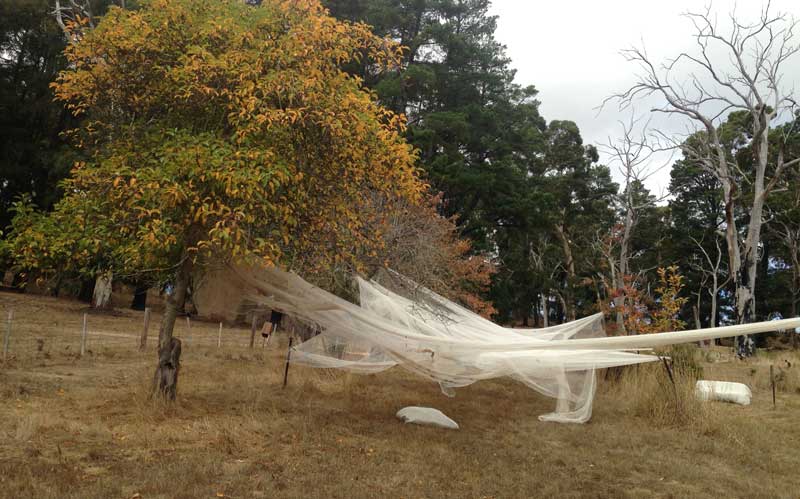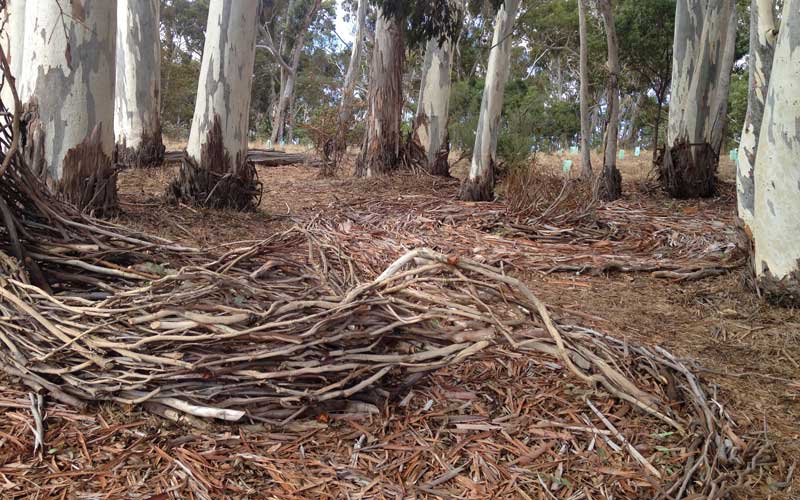
It is already April by the time I make the pilgrimage up the hill to see the Heysen Sculpture Biennial. The bright lushness of the hills towns like Stirling falls away when I step out of the car at The Cedars. But there is still some bite in the sun on the back of my neck as a reminder that even in the astringent autumnal light this is a landscape in which I have to take extra care. Here, where the eye wants to sweep upward to the cathedral of trees, the crackling of dried leaves underfoot is a reminder also to keep on the lookout at ground level.
Walking the path that is mapped out in the catalogue, I visit each artwork one by one. This is the first year that the biennial’s organising committee has received funding to engage a curator, and I am keen to see how Stephanie Radok’s vision for the biennial unfolds across the estate. Momentarily lost at the very start of the journey, I spend a few minutes poring over the map and checking my position while looking for a monumental rusted sculpture typical of Greg Johns.
I finally give up and walk towards a roped off area, curious to see what the physical barrier is for. Once there I realise that Johns has moved underground this year, a successful reversal. The seven perfectly round holes are covered with patterned metal covers of varying density of pattern, which allow glimpses of the yellow clay underground. Already in this work (an anti-monument perhaps) as Radok suggests in her catalogue statements, “We dwell … Treading lightly, thinking green, working ecologically and engaging with a sense of place.”
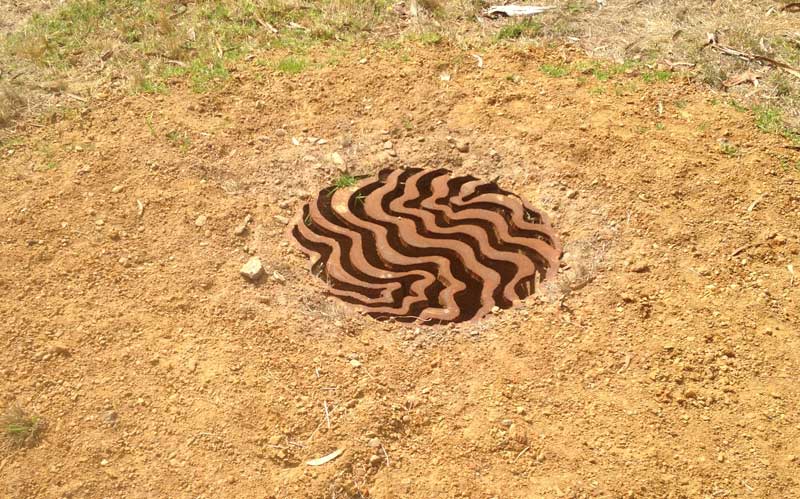
Further on, and perhaps slightly at odds with this concept of engaging with place, Lorry Wedding-Marchioro’s luminous seed-pod forms sway voluptuously in the breeze, hypnotic in their otherness. Viewed from one direction the pods are set against the cultivated garden surrounding the main house. Looking back the other way they stand out in front of the scratchy trees that herald the start of the native plants on the property, leading the viewer off the garden path and into the bush. They don’t quite belong to either vista—something that is highlighted by their positioning slightly away from the copse of trees.
Another artwork that sits in uneasy juxtaposition to the surrounding bush is Quentin Gore’s Globulous, which are also reminiscent of seed pods or—smaller still—microscopic images of an itch or irritation, like a disease. They stand on the pale dry grass as invading forces, as something that catches and causes damage. Dwell Time by Mary Ann Satin also invades space: in the orchard web-like nets are hung, stretched out between the trees. Satin created the work from recycled bird netting to interrupt the view of Heysen’s iconic lone gum, already disrupted by the planting of the orchard. As netting, the installation also highlights the danger to birds and wildlife that such interventions into the landscape create.
It was not until later in my walk that I stopped thinking about the sculptures in terms of the idea of land and landscape and started to really think about the artworks in relation to the idea of dwelling. It was Papa Tjukurpa: Dingo Story by Clancy Warner and Elizabeth Close that did it. Walking along the track the dingoes becomes visible in the clearing amongst a stand of trees. At the time of my visit the sun lit up the bronze, shining flanks of the prostrate dog. The standing dingo is taut and aware. The only way to approach these dingoes is to startle them. This more than anything here makes me question my place in this landscape in relation to what might already be dwelling there.
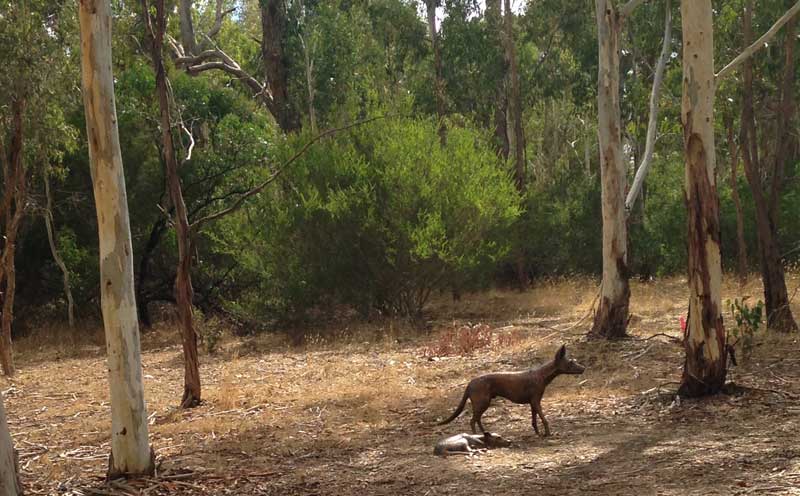
Evette Sunset, another veteran of the Heysen Sculpture Biennial, created her installation As Within So Without, on site among the candle barks. The journey of the trees outwards, growing and spreading seed is brought out in the swirling flood of bark and branches that Sunset has meticulously laid out—a sea that rears up in boat-shaped vessels that protect young saplings. A different life force is at work here, Sunset’s swirling patterns evoke the flowing of sap and the slow unfolding life that goes on with or without our presence.
Amidst these new works, a few of the remnant sculptures from previous biennials sit like the rusting hulks in this landscape, but Radok’s vision for the Cedars is lighter and more questioning. Radok has chosen artists through an application process, and this has led to a somewhat random experience when moving from sculpture to sculpture. But the time that she spent walking over this dry ground is evident. It is an exhibition that does require a commitment to traversing land. The time that it takes to do this allows for a slower appreciation of the works and their placement. The overall vision is not of a comprehensive theme but more one of unfolding ideas around our inhabitation of the landscape, particularly who we share the landscape with.
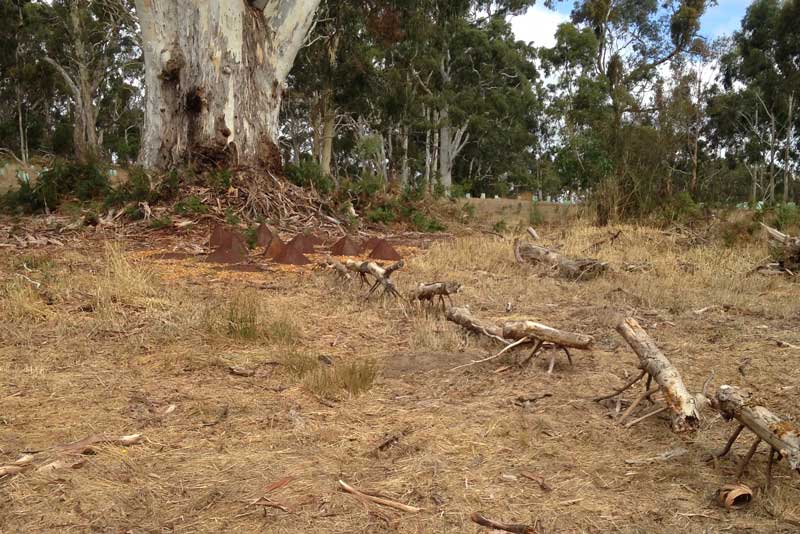
The only sculptural figures populating this dusty landscape are in animal form. Apart from the shelters in Ron Rowe’s Campsite built to human scale the reference points are all to our non-human animal others. These include Jojo Spook’s Spook Dogs, the ants in Going Home by Tim Thomson and David Jones, the dingoes by Clancy Warner and Elizabeth Close already mentioned, Phillip McGillivray-Tory’s insect house and Nicholas Uhlmann’s monumental bird sculpture Grounded. They join a population of living ants, squawking birds, and the insects who worm their way silently though the wood of fallen branches. As if to highlight the turn of our attention to this other world, while I am there two people spend some time inspecting a termite mound, the man butts his foot against it to test its solidity.
The exhibition shifts the view from that of landscape as a sculptural park and estate honouring human settlement, to this more ecological way of being, and even towards reconciliation. Perhaps, as Radok intimates in her catalogue essay, the trees are the real heroes of this exhibition. I returned again and again to staring at multi-coloured and textured barks of the many species that cover this special property. As Radok states: “If we can begin to see that the lives of the trees that dwell around us are as important as our own then we will be getting somewhere.”
